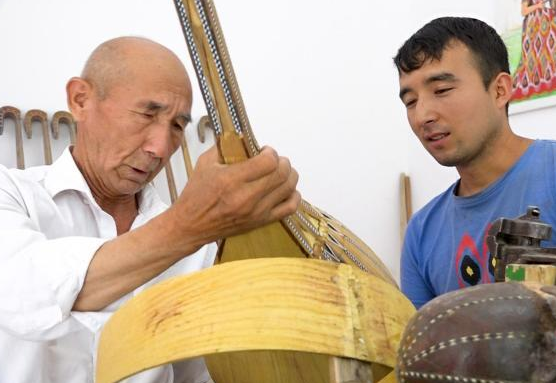Inheritance and Development of Traditional Ethnic Musical Instruments in Xinjiang
In traditional Uyghur music, there are a wide variety of musical instruments, such as: Aiczech, Tanbul, Revafu, tambourine, etc., which can be said to be played, pulled, played, played, everything. Musical instruments are essential not only in daily life, but also during the "Maisirefu" held by the public, and even during wonderful acrobatic performances.

These musical instruments accompany the spiritual life of the Uighur people and have experienced a long development path. Nowadays, it is not only a musical instrument, but also an exquisite handicraft.

Maimeti Tolson Ababurj is making musical instruments
Adhere to traditional handwork to create national musical instruments
"Bazaar, a musical instrument in the ancient city of Kashgar, is playing Uyghur folk music with two close friends from the fifth generation musical instrument producer Maimaiti Turson Ababurj in the ethnic instrument store run by generations.". "Mai Mai Ti Tu Er Xun told reporters that his grandfather was the producer of the musical instruments used in the film" Guests on the Iceberg. ". From the age of 12, Mai Mai Ti Tu Er Xun has learned a lot of musical instrument knowledge from his grandfather. He began to learn musical instrument production from his father. Today, Mai Mai Ti Tu Er Xun has learned to make more than 40 ethnic musical instruments.
"At that time, my grandfather liked to play Dutar, my father beat the tambourine, and we danced together. At that time, relatives and friends liked to come to our house, where everyone would share delicious food and listen to songs and dances. It was very lively."
In Mai Mai Ti Tu Er Xun's ethnic musical instrument store, a variety of musical instruments are overwhelming, and most of them are handmade by Mai Mai Ti Tu Er Xun. A piece of wood, through the unremitting efforts of Mai Mai Ti Tu Er Xun, through the processes of drawing, carving, polishing, painting, and winding, gradually presented to the world one by one.
"Mai Mai Ti Tu Er Xun introduced, 'Re Wa Fu has seven strings, and musical instruments made of different materials will also have different sound qualities. The sound color of a piano made of apricot wood will be better. Making a Re Wa Fu usually takes about 15 days, but to make the best one, it takes at least about a month.'"

Anivar Asimu is learning to make musical instruments from his master
National Musical Instruments "Crossing the Ocean" Go to the World
In addition to various musical instruments, on the wall of the entrance to the ethnic musical instrument store in Maimeti Turson, there are photos of him with tourists from around the world, as well as photos of his family making musical instruments. As he walked, he introduced to the reporter, "This is a Japanese tourist from 1999, this is an American tourist from 2000 in the store, and this is an Israeli tourist from 2001. These tourists all like the handmade musical instruments we make. This is our family's relatives, this is my father, my uncle, and several relatives' uncles."
Nowadays, with the ingenious hand of Mai Mai Ti Tu Er Xun, each huge and bulky musical instrument is made into a small and exquisite handicraft in proportion, a key ring, a small ornament, or a pendant, which is both flattering and endearing, and naturally many people buy it. Ms. Wang, from Shanghai, is selecting her favorite souvenirs for tourism. She said, "These musical instruments are all very beautiful. I really like these works, and I want to take each one back. I plan to give it to my family or put it at home."
As a representative inheritor of intangible cultural heritage at the autonomous region level, Maimeti Turson Ababurge, as the fifth generation inheritor of family made musical instruments, has more expectations for the future of musical instrument inheritance, He said: "Now all countries along the the Belt and Road like our music, and we will also strengthen the exchange of musical instruments and music. In the future, we want to expand the scale of stores, not only to process and produce Uygur musical instruments, but also to process musical instruments of other nationalities."
Inheritance and development of traditional culture
Shufu County, just 15 kilometers away from Kashgar, is the birthplace of "Shule Music" in the Tang Dynasty. Here is a musical instrument museum that displays all the traditional musical instruments of the modern Uyghur ethnic group, as well as a well-known musical instrument village. Here, making ethnic musical instruments has become a proud technology. Many young people learn to play and make local old artists as their teachers, including Anivar Asimu. He told reporters, "At first, I saw my master making musical instruments and thought it was relatively easy to make them. However, after trying to make them myself, I suffered a lot and found it difficult to make them. In the middle, I also damaged several musical instruments. My master patiently taught me, corrected the mistakes and taught me repeatedly."
The master patiently taught, while Enival worked hard to learn. Today, he has learned to make more than a dozen musical instruments, including Dutar, Gewap, Tabor, tambourine, and Aiczech, among which Dutar is his most skilled.
In June 2008, the "National Musical Instrument Making Skills" in Shufu County was listed as a national intangible cultural heritage project. In order to revitalize the musical instrument making skills, the local government established a creation platform for the National Musical Instrument City to cultivate professional talents, enable the musical instrument making skills to "live up" on the industrialized platform, and obtain more effective protection and inheritance.
 渝公网安备 50010702504639号
渝公网安备 50010702504639号